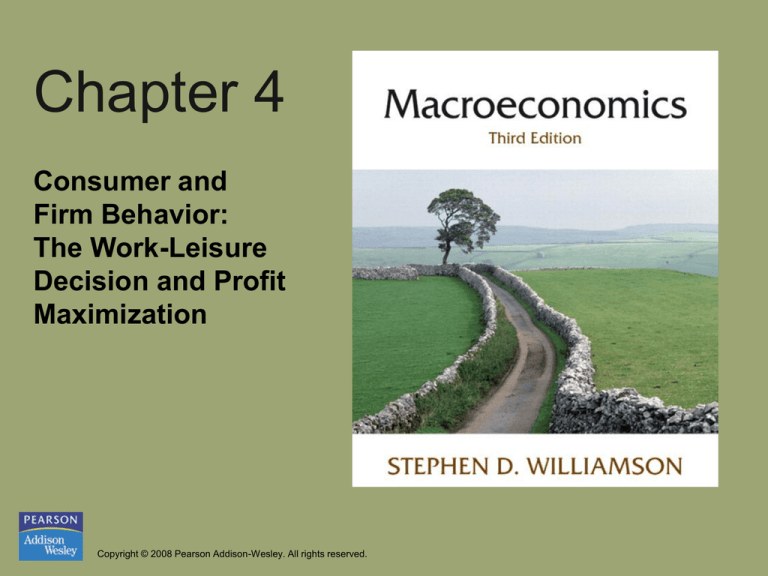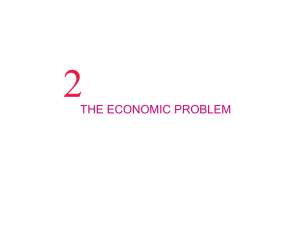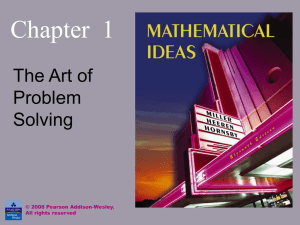
Chapter 4
Consumer and
Firm Behavior:
The Work-Leisure
Decision and Profit
Maximization
Copyright © 2008 Pearson Addison-Wesley. All rights reserved.
Chapter 4 Topics
• Behavior of the representative consumer
• Behavior of the representative firm
Copyright © 2008 Pearson Addison-Wesley. All rights reserved.
4-2
Representative Consumer
• Consumer’s preferences over consumption and leisure
as represented by indifference curves.
• Consumer’s budget constraint.
• Consumer’s optimization problem: making his or
herself as well off as possible given his or her budget
constraint.
• How does the consumer respond to: (i) an increase in
non-wage income; (ii) an increase in the market real
wage rate?
Copyright © 2008 Pearson Addison-Wesley. All rights reserved.
4-3
Representative Consumer’s
Indifference Curves
• An indifference curve slopes downward (more is
preferred to less).
• An indifference curve is convex (the consumer
has a preference for diversity in his or her
consumption bundle).
Copyright © 2008 Pearson Addison-Wesley. All rights reserved.
4-4
Figure 4.1 Indifference Curves
Copyright © 2008 Pearson Addison-Wesley. All rights reserved.
4-5
Figure 4.2 Properties of
Indifference Curves
Copyright © 2008 Pearson Addison-Wesley. All rights reserved.
4-6
Equation 4.1: The consumer’s
time constraint
Copyright © 2008 Pearson Addison-Wesley. All rights reserved.
4-7
Equation 4.2: The consumer’s
budget constraint
Copyright © 2008 Pearson Addison-Wesley. All rights reserved.
4-8
The Consumer’s Budget
Constraint
• Consumption is equal to total wage income, plus
dividend income, minus taxes.
Copyright © 2008 Pearson Addison-Wesley. All rights reserved.
4-9
Equation 4.3: Budget constraint
accounting for time constraint.
Copyright © 2008 Pearson Addison-Wesley. All rights reserved.
4-10
Equation 4.4: Rewriting the
Budget Constraint
Copyright © 2008 Pearson Addison-Wesley. All rights reserved.
4-11
Equation 4.5: Rewriting the
Budget Constraint Again
Copyright © 2008 Pearson Addison-Wesley. All rights reserved.
4-12
Figure 4.3 Representative
Consumer’s Budget Constraint (T > π)
Copyright © 2008 Pearson Addison-Wesley. All rights reserved.
4-13
Figure 4.4 Representative
Consumer’s Budget Constraint (T < π)
Copyright © 2008 Pearson Addison-Wesley. All rights reserved.
4-14
Consumer Optimization
The consumer chooses the consumption bundle
that is on his or her highest indifference curve,
while satisfying his or her budget constraint.
Copyright © 2008 Pearson Addison-Wesley. All rights reserved.
4-15
Figure 4.5 Consumer
Optimization
Copyright © 2008 Pearson Addison-Wesley. All rights reserved.
4-16
Equation 4.6: Holds when the
consumer is optimizing
The marginal rate of substitution of leisure for
consumption equals the real wage.
Copyright © 2008 Pearson Addison-Wesley. All rights reserved.
4-17
Figure 4.6 The Representative
Consumer Chooses Not to Work
Copyright © 2008 Pearson Addison-Wesley. All rights reserved.
4-18
Real dividends or taxes change
for the consumer
• Assume that consumption and leisure are both
normal goods.
• An increase in dividends or a decrease in taxes
will then cause the consumer to increase
consumption and reduce the quantity of labor
supplied (increase leisure).
Copyright © 2008 Pearson Addison-Wesley. All rights reserved.
4-19
Figure 4.7 An Increase in π − T
for the Consumer.
Copyright © 2008 Pearson Addison-Wesley. All rights reserved.
4-20
An increase in the market real
wage rate
• This has income and substitution effects.
• Substitution effect: the price of leisure rises, so the
consumer substitutes from leisure to consumption.
• Income effect: the consumer is effectively more
wealthy and, since both goods are normal, consumption
increases and leisure increases.
• Conclusion: Consumption must rise, but leisure may
rise or fall.
Copyright © 2008 Pearson Addison-Wesley. All rights reserved.
4-21
Figure 4.8 Increase in the Real Wage
Rate—Income and Substitution Effects
Copyright © 2008 Pearson Addison-Wesley. All rights reserved.
4-22
Figure 4.9 Labor Supply
Curve
Copyright © 2008 Pearson Addison-Wesley. All rights reserved.
4-23
Figure 4.10 Effect of an Increase in
Dividend Income or a Decrease in Taxes
Copyright © 2008 Pearson Addison-Wesley. All rights reserved.
4-24
Figure 4.11 Perfect Complements
Copyright © 2008 Pearson Addison-Wesley. All rights reserved.
4-25
The Representative Firm
• The production function.
• Profit maximization and labor demand.
Copyright © 2008 Pearson Addison-Wesley. All rights reserved.
4-26
Equation 4.9: The Firm’s
Production Function
Copyright © 2008 Pearson Addison-Wesley. All rights reserved.
4-27
Properties of the Firm’s
Production Function
• Constant returns to scale.
• Output increases with increases in either the labor input
or the capital input.
• The marginal product of labor decreases as the labor
input increases.
• The marginal product of capital decreases as the capital
input increases.
• The marginal product of labor increases as the quantity
of the capital input increases.
Copyright © 2008 Pearson Addison-Wesley. All rights reserved.
4-28
Figure 4.12 Production Function, Fixing the
Quantity of Capital and Varying the Quantity
of Labor
Copyright © 2008 Pearson Addison-Wesley. All rights reserved.
4-29
Figure 4.13 Production Function, Fixing
the Quantity of Labor and Varying the
Quantity of Capital
Copyright © 2008 Pearson Addison-Wesley. All rights reserved.
4-30
Figure 4.14 Marginal Product of Labor
Schedule for the Representative Firm
Copyright © 2008 Pearson Addison-Wesley. All rights reserved.
4-31
Figure 4.15 Adding Capital Increases
the Marginal Product of Labor
Copyright © 2008 Pearson Addison-Wesley. All rights reserved.
4-32
Figure 4.16 Total Factor
Productivity Increases
Copyright © 2008 Pearson Addison-Wesley. All rights reserved.
4-33
Figure 4.17 Effect of an Increase in Total
Factor Productivity on the Marginal Product
of Labor
Copyright © 2008 Pearson Addison-Wesley. All rights reserved.
4-34
Equation 4.10: Specific
Production Function
Copyright © 2008 Pearson Addison-Wesley. All rights reserved.
4-35
Equation 4.11: Solow Residual
Copyright © 2008 Pearson Addison-Wesley. All rights reserved.
4-36
Figure 4.18 The Solow Residual
for the United States
Copyright © 2008 Pearson Addison-Wesley. All rights reserved.
4-37
Equation 4.12: Profit
Maximization
When the firm maximizes profits, the marginal
product of labor equals the real wage.
Copyright © 2008 Pearson Addison-Wesley. All rights reserved.
4-38
Figure 4.19 Revenue, Variable
Costs, and Profit Maximization
Copyright © 2008 Pearson Addison-Wesley. All rights reserved.
4-39
Figure 4.20 The Marginal Product of
Labor Curve Is the Labor Demand Curve
of the Profit-Maximizing Firm
Copyright © 2008 Pearson Addison-Wesley. All rights reserved.
4-40







